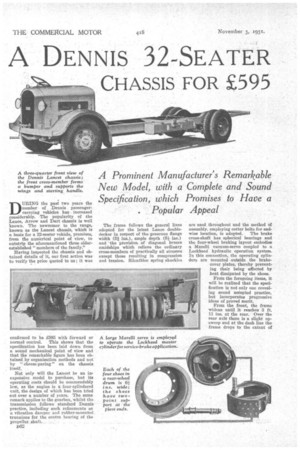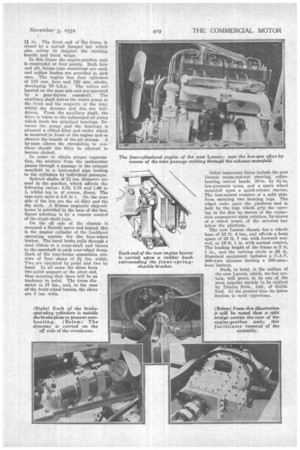A DENNIS 32-SEATER
Page 148

Page 149

If you've noticed an error in this article please click here to report it so we can fix it.
CHASSIS FOR £595
DURING the past. two years the number of Dennis passenger. carrying vehicles has increased considerably. The popularity of the Lance, Arrow and Dart chassis is well known. The newcomer to the range, known as the Lancet chassis, which is a basis for a 32-seater vehicle, promises, from the numerical point of view, to outstrip the aforementioned three olderestablished "members of the family."
Having inspected the chassis and obtained details of it, our first action was to verify the price quoted to us ; it was confirmed to be £595 with forward or normal control. This shows that the specification has been laid down from a sound mechanical point of view and that the remarkable figure has been obtained by organization methods and not by `! cheese-paring" on the chassis itself_
Not only will the Lancet be an inexpensive model to purchase, but its operating costs should be commendably low, as the engine is a four-cylindered unit, the design of which has been tried out over a number of years. The same remark applies to the gearbox, whilst the transmission follows standard Dennis practice, including such refinements as a vibration damper mid rubber-mounted trunnions for the centre bearing of the
propeller. shaft. .. Af..52 The frame follows the general lines adopted for the latest Lance doubledecker in respect of the generous flange width (3i ins.), ample depth (8,ins.) and the provision of diagonal braces amidships which relieve the ordinary cross-members of practically all stresses except those resulting in compression and tension. Silen.tbloe spring shackles
are used throughout and the method of assembly, employing cotter bolts for endwise location, is adopted. The brake cross-shaft has spherical bearings and the four-wheel braking layout embodies
Mardi vacuum-servo coupled to a Lockheed hydraulic operation system. In this connection, the operating cylinders are mounted outside the brakecover plates, thereby preventing their being affected by heat dissipated by the shoes.
From the foregoing items, it will be realized that the specification is not only one revealing sound accepted practice, but incorporates progressive ideas of proved merit.
From the front, the frame widens until it reaches 3 ft. 11 ins, at the rear. Over the rear salt there is a slight upsweep and at the dash line the frame drops to the extent of
11 in. The front end of the frame is closed by a curved bumper bar which also serves to support the starting handle and front wings.
In this frame the engine-gearbox unit is susliended at four points. Both fore and aft, bridge-type mountings are used, and rubber bushes are provided in each case. The engine has four cylinders of 110 mm. bore and 150 min. stroke, developing 70 b.b.p. The valves are located on the near side and are operated by a gear-driven camshaft. The auxiliary shaft drives the water pump at the front and the magneto at the rear, whilst the dynamo and fan arc beltdriven. From the auxiliary shaft, the drive is taken to the submerged oil pump which feeds the principal bearings. Between the pump and the bearings is situated a ribbed filter and cooler which is mounted in front of the engine and so obtains the benefit of the air stream. .A by-pass allows the circulation to continue should the filter be allowed to become choked.
In order to obtain proper vaporization, the mixture from the carburetter passes through a passage in the exhaust manifold to a butt-ended pipe leading to the cylinders by individual passages.
SPlined shafts of 21 ins, diameter are used in the gearbox, which affords the following ratios: 5.32, 2.79 and 1.69 to 1, whilst top is, of course, direct. The rear-axle ratio is 5.6 to 1. On the near side of the box are the oil filler and the dip stick. A Simms magnetic chip-collector is provided in the base of the box. Speed selection is by a remote control of the single-shaft type.
On the off side of the chassis is mounted a MarelIi servo and behind this is the master cylinder of the Lockheed operating system for the four-wheel brakes. The hand brake pulls through a steel ribbon to a cross-shaft and thence to the camshaft in each rear-wheel drum. Each of the rear-brake assemblies consists of four shoes of 61 ins. width. Two are operated by pedal and two by hand. In all cases the shoes have two-point support at the pivot end,
thus ensuring that there will be no tendency to twist. The drum diameter is 17 ins. and, in the case of the front-whee!I brakes, the shoes are 3 ins. wide.
Other important items include the new Dennis worm-and-not steering, rollerbearing swivel heads, 36-in. by 8i-in. low-pressure tyres, and a spare wheel mounted upon a quick-release carrier. The last-named consists of a split platform carrying two locating lugs. The whoel rests upon the platform and is held by the logs which grip the opening in the disc by means of the expansion consequent upon rotation, by means of a wheel brace, of the screwed bar below the platform.
The new Lancet chassis has a. wheel. base of 16 ft. 4 ins., and affords a body space of 22 ft. 7 ins, with forward control, or 18 ft. 1 in. with normal control. The loading height of the frame is 2 ft. 1 in.. and the turning circle is .58 ft. Standard equipment includes a C.A.V. 400-watt dynamo feeding a 200-amp.hour battery.
Such, in brief, is the outline of the new Lancet, which, we. feel cer--tain, will prove to be one of the most popular models to be evolved by Dennis Bro., Ltd., of Guildford. At the present time its intro. duction is most opportune.








































































































































































































































